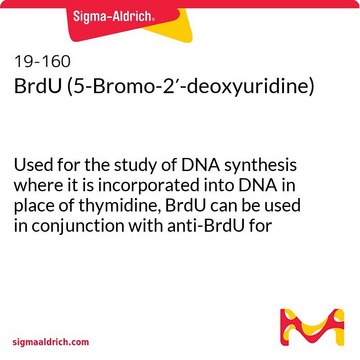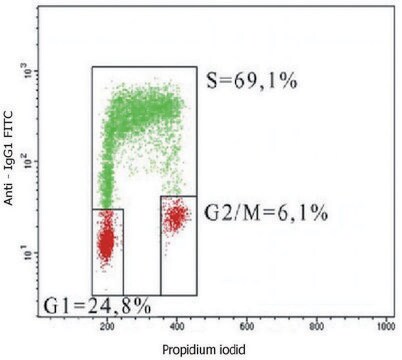MAB4072
Anti-BrdU Antibody, clone 131-14871
clone 131-14871, Chemicon®, from mouse
Sinônimo(s):
BrdU
About This Item
Produtos recomendados
fonte biológica
mouse
Nível de qualidade
forma do anticorpo
purified immunoglobulin
tipo de produto de anticorpo
primary antibodies
clone
131-14871, monoclonal
reatividade da espécie (prevista por homologia)
all
fabricante/nome comercial
Chemicon®
técnica(s)
flow cytometry: suitable
immunohistochemistry (formalin-fixed, paraffin-embedded sections): suitable
Isotipo
IgG1
Condições de expedição
wet ice
modificação pós-traducional do alvo
unmodified
Descrição geral
Especificidade
Aplicação
Flow cytometry on 100μL of 106 cells: 1:5000.
Optimal dilutions must be determined by the end user.
IMMUNOHISTOCHEMICAL PROCEDURE
FOR PARAFFIN EMBEDDED TISSUE SECTIONS
STAINING PROCEDURE:
1. Deparaffinize sections in xylene 3 x 5 minutes. Resin embedded or GMA (Glycol methacrylate, 2-hydroxyethyl methacrylate) treated sections it is unnecessary to deparaffinize as there is no paraffin.
2. Place slides in graded alcohols (100, 95, 90%) to water at 2 minute intervals, and air dry. (Omit for GMA sections)
3. Circle sections with PAP pen or diamond pen to identify and dry thoroughly.
4. For GMA or resin sections, place slides in 0.5% Tween/PBS (pH 7.6) for 29 minutes.
5. Incubate in prewarmed (40°C) 1N HCl for 1 hour.
6. Wash 3 x 3 minutes with PBS (pH 7.6). Slides may be held at this point and the procedure continued the following day.
7. Incubate in 1X Trypsin solution (0.02-0.05% w/v, prewarmed to 40°C) for 20 minutes at room temperature for NBF (normal buffered formalin) fixed tissue or 10 minutes for Carnoy′s fixed tissue.
8. Wash 3 x 5 minutes with PBS (pH 7.6).
9. Incubate sections in 1% H2O2 (10 mL 30% H2O2 in 290 mL methanol) for 20 minutes, or GMA sections in 3% H2O2 (10 mL 30% H2O2 in 90 mL water) for 3 minutes.
10. Wash 2 x 2 minutes with PBS (pH 7.6).
11. Using the Vector ABC kit, add 3 drops of normal horse serum to 10 mL of PBS. Use this solution to block the slides for 20 minutes at room temperature.
12. Blot the slides of excess normal horse serum and incubate with MAB4072 diluted in PBS/BSA/Tween 20 for 1 hour at room temperature.
13. Wash 3 x 3 minutes with PBS (pH 7.6).
14. Add 3 drops of normal horse serum to 10 mL of PBS and then add 1 drop of biotinylated antibody stock. Incubate the slides with this diluted second antibody for 30 minutes at room temperature.
15. Prepare the Vectastain ABC Reagent by adding 2 drops of reagent A to 5 mL of PBS. Then add 2 drops of Reagent B to the same mixing bottle. Allow to sit for about 30 minutes prior to use.
16. Wash 3 x 3 minutes with PBS (pH 7.6).
17. Incubate the slides with ABC Reagent for 30 minutes at room temperature.
18. Wash 3 x 3 minutes with PBS (pH 7.6).
19. Prepare the substrate by mixing an equal volume of 0.02% H2O2 (made in distilled water from a 30% stock solution) and 0.1% DAB made in 0.1 M Tris buffer, pH 7.2. The H2O2 should be freshly prepared from concentrated stock. Because many peroxide substrates are unstable in the presence of H2O2 or when exposed to light, the substrate should be prepared just prior to use. Since DAB is a suspected carcinogen, care should be taken in handling and disposing of all peroxidase substrates.
20. Stain the slides with DAB substrate for 2-5 minutes.
21. Wash 2 x 2 minutes with distilled water.
22. Counterstain with hemotoxylin, dehydrate through xylene, and mount the coverslip.
Epigenetics & Nuclear Function
Cell Cycle, DNA Replication & Repair
forma física
Armazenamento e estabilidade
Nota de análise
Brdu treated cells
Outras notas
Informações legais
Exoneração de responsabilidade
Não está encontrando o produto certo?
Experimente o nosso Ferramenta de seleção de produtos.
Código de classe de armazenamento
12 - Non Combustible Liquids
Classe de risco de água (WGK)
WGK 2
Ponto de fulgor (°F)
Not applicable
Ponto de fulgor (°C)
Not applicable
Certificados de análise (COA)
Busque Certificados de análise (COA) digitando o Número do Lote do produto. Os números de lote e remessa podem ser encontrados no rótulo de um produto após a palavra “Lot” ou “Batch”.
Já possui este produto?
Encontre a documentação dos produtos que você adquiriu recentemente na biblioteca de documentos.
Os clientes também visualizaram
Nossa equipe de cientistas tem experiência em todas as áreas de pesquisa, incluindo Life Sciences, ciência de materiais, síntese química, cromatografia, química analítica e muitas outras.
Entre em contato com a assistência técnica











